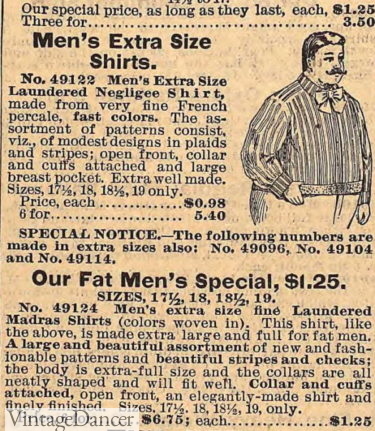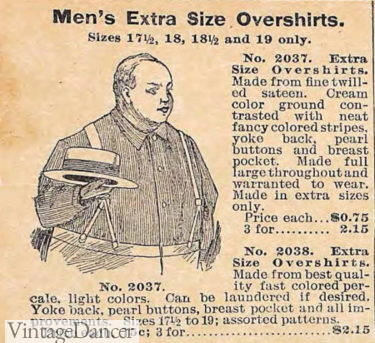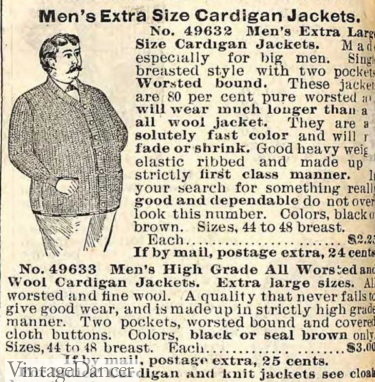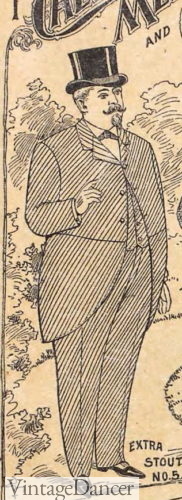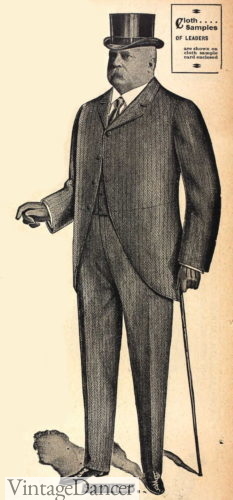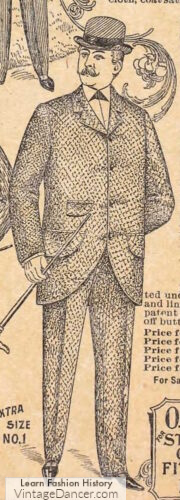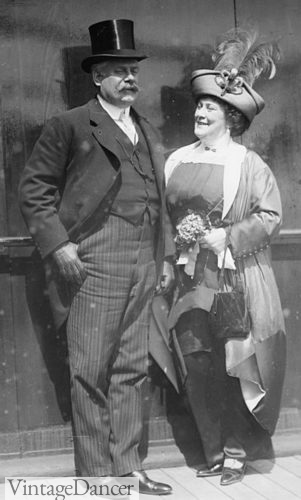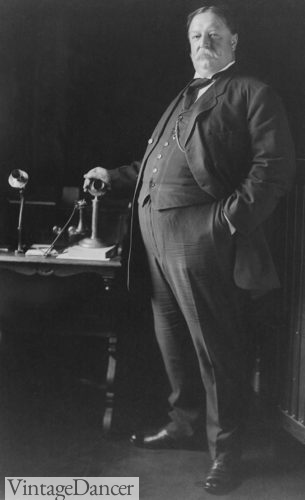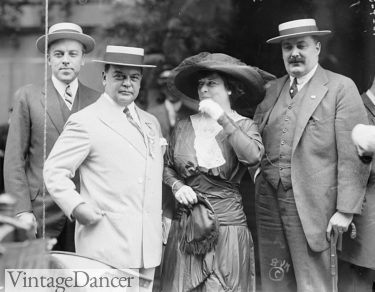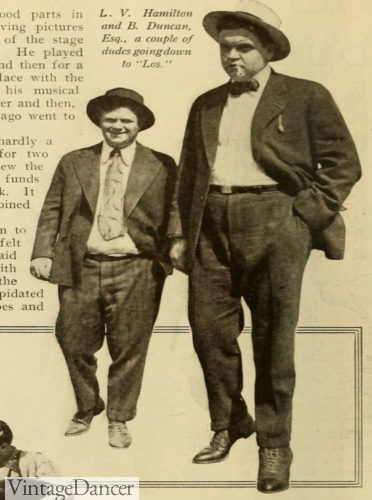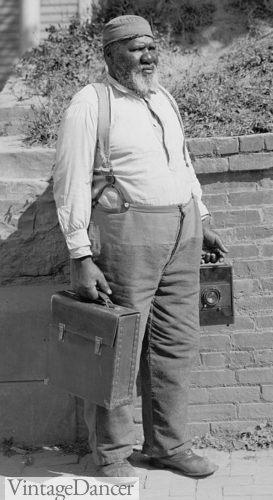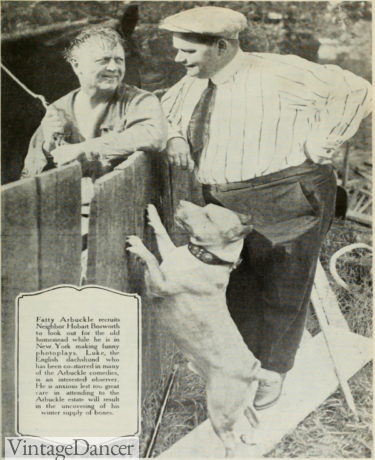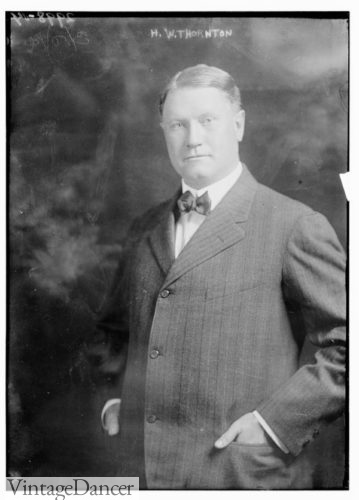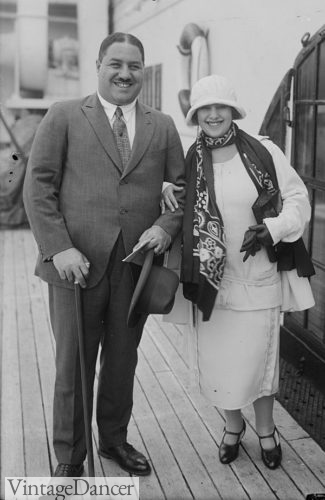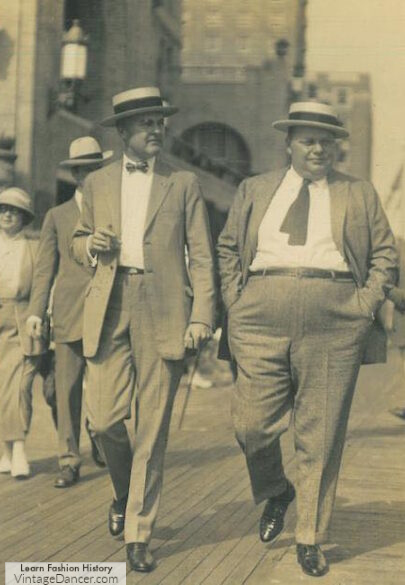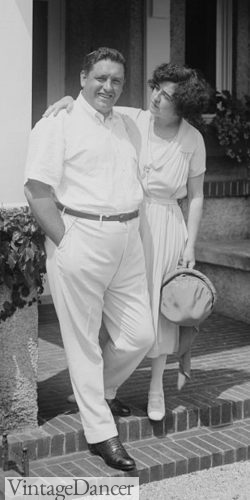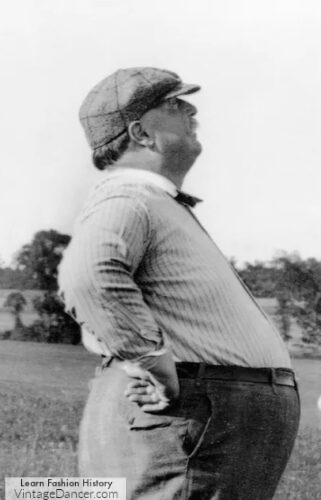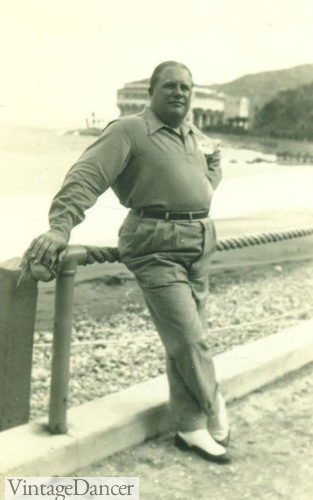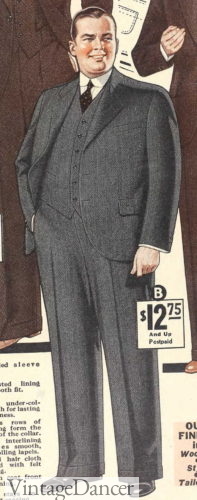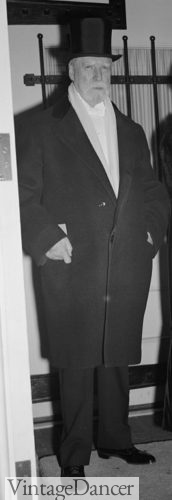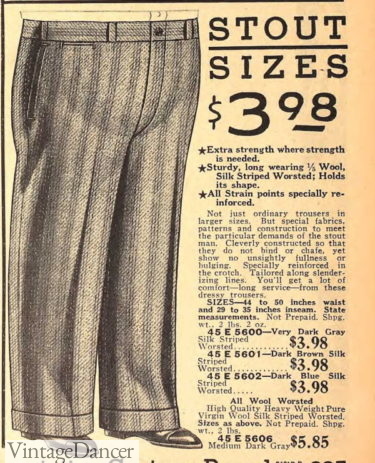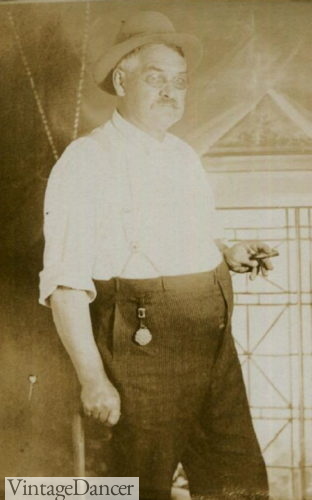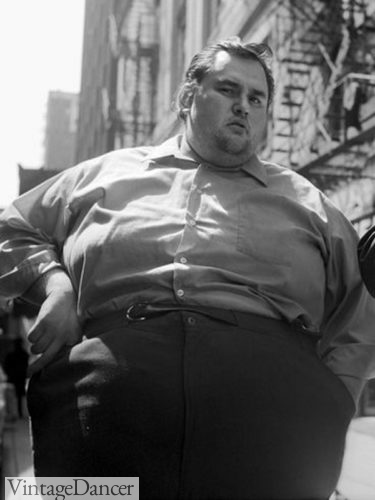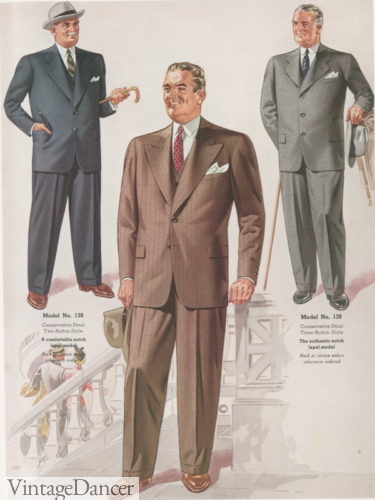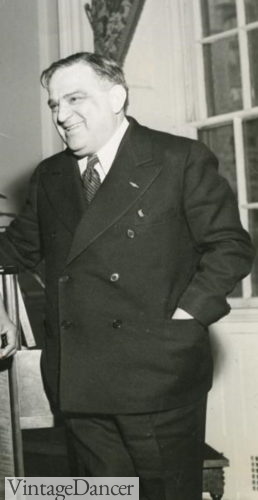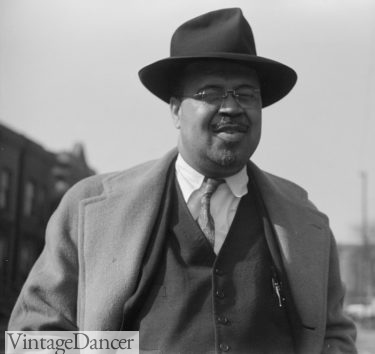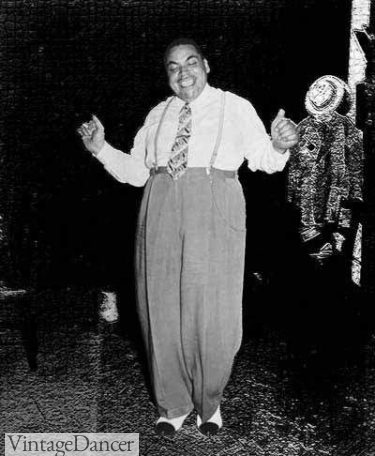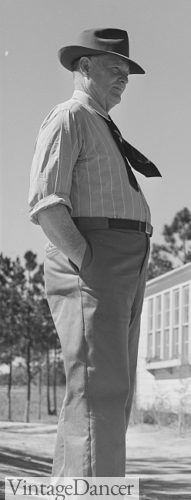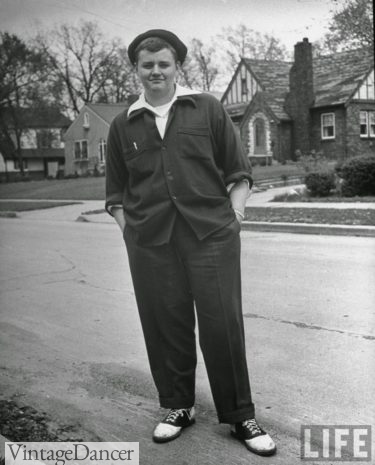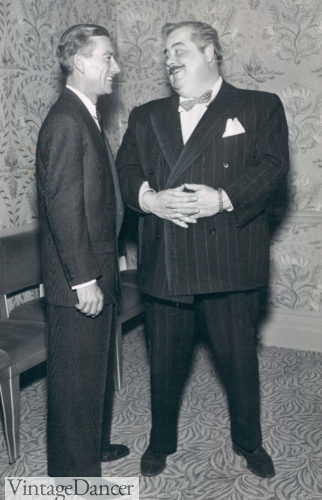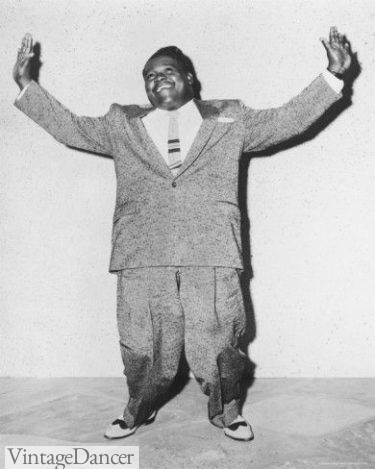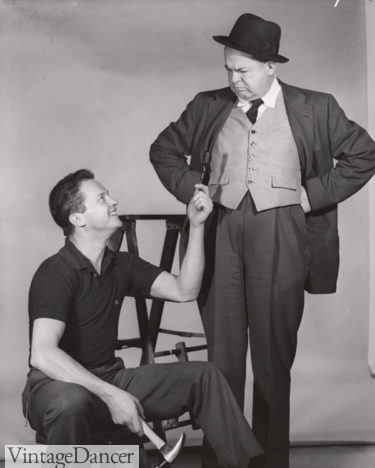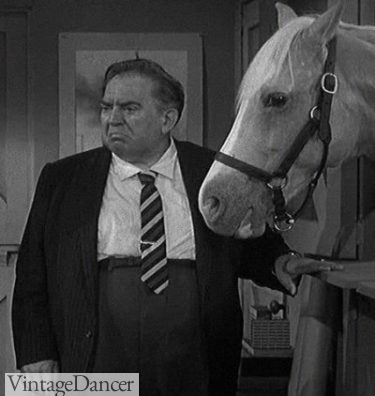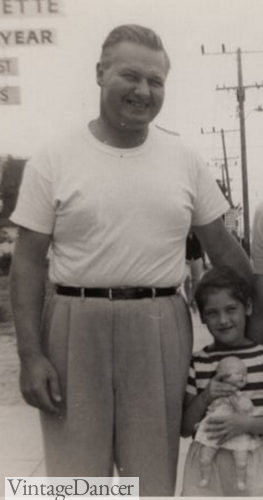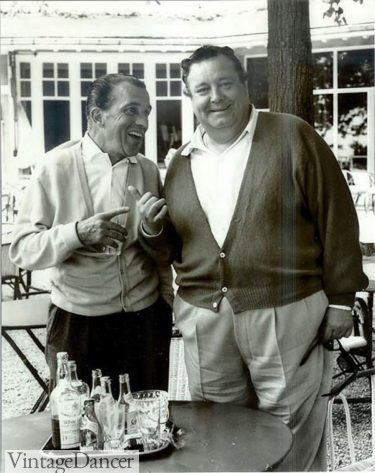Men’s big and tall vintage clothing has a history that begins with the standardization of clothing sizes. Any man whose height and or width expanded beyond the average sizes relied on custom made clothing for his needs until retailers began offering standard sizes for extra large men. Initially the section was small and plain but as waistlines expanded through the decades so did the choices.
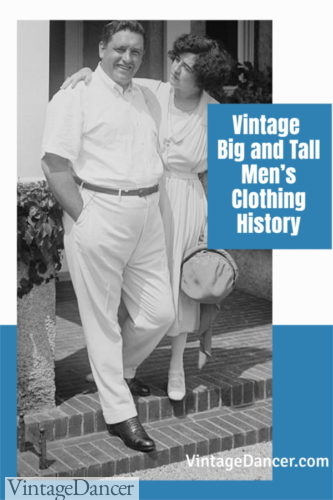
How did big men dress in vintage clothing in the 1900s, 1910s, 1920s, 1930s, 1940s, 1950s, etc? This is a question I have seen asked a few times yet the research has not been done… until now.
I searched through my vast collection of clothing catalogs and photo archives to find examples of vintage men’s clothing in larger sizes. It is my hope these will confirm that 1. yes, big men did wear vintage clothing, and 2. recommended shops to achieve the vintage look today.
Names for Big & Tall Clothing
Around the turn of the century clothing was made to measure. There was no need for special size names since general sizes did not exist. Sears and similar mail order catalogs were changing that. While they did make made-to-measure clothing for any size man, some clothing such as underwear, knitwear, and shirts were being offer in standard sizes.
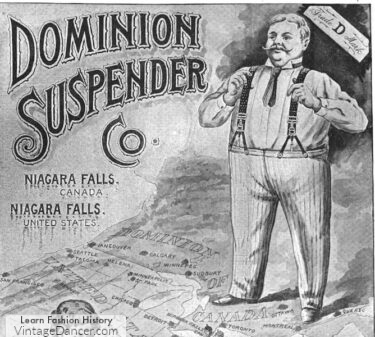
1894 ad for Dominion suspenders
Anything beyond these standards were called “extra size,” “extra large,” “stout size,” and occasionally clothing for “fat,” “portly” or “corpulent” men.
Stout usually referred to men with a wide waist. Stout-short, stout-tall, and semi-stout described some variation in height. For men who were tall but not wide, there were less options for ready-made clothing. Shirts were usually long enough while longer length trousers needed to be custom made.
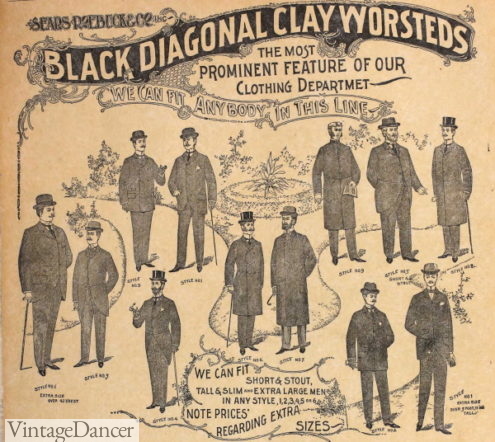
1897 Sears advertises clothing made for “Short & Stout, Tall & Thin- Extra Large Men in any style”
Underwear, however, was made longer in the torso and legs for “tall-slim” men and shorter for “stout-short” men.
By the early 1900s, “stout” seemed to be the most common term for both women and men’s larger size clothing. Stout men’s suit sizes were chest 43 to 50 inches in the Sears catalogs. Shirts were sold by collar size from 17.5 to 20 inches. Sweaters were 44-48 inch chest sizes. Trousers were 43-50 inch waist and 29-36 inch inseam.
In the 1940s, a shift away from using “stout” was happening. Men’s clothing was now “extra large” size. Catalogs were offering men’s extra large sizes on select, basic pieces only. Out of an entire catalog you were lucky to find 1-2 trousers, 1-2 single breasted plain suits, 1 cardigan sweater, 1 dress shirt, work shirt and jacket. However the “average” size clothing now went up to a 46 chest.
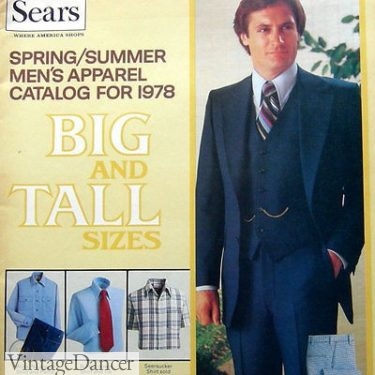
1978 Sears Big and Tall Catalog
In the 1970s and 1980s Sears launched a dedicated catalog to all clothing in Big or Tall sizes. In the regular catalogs and in stores they offered pants up to 44 and shirts and coats up to 47 chest. There were now many more options for clothes in tall lengths too.
Today women’s fashion has “plus size” or “curvy” to describe larger clothing sizes, but for men the fashion industry has yet to agree on a term. Big and tall seems to be the only consistently used term referring to either big or tall, not exclusively one or the other. Husky, King Size, plus size, big men and extra large are used by some retailers.
For the rest of this article I will use many past and current terms interchangeably. This is not meant to start a debate or cause a slew of nasty comments, rather to appeal to the search algorithms (Google) and the many terms people use to search for men’s vintage clothing in plus sizes.
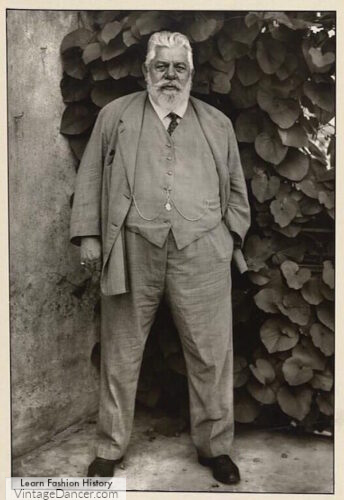
A sack suit worn by a stout man, date unknown, about 1920
Edwardian Large Men’s Clothing 1890-1910s
In the 1890s to 1910s, the Edwardian era, was no stranger to corpulent size men. A fat man was often a wealthy man who could afford good meat and his own tailor. Most prestigious and wealthy men, important senators, kings and businessmen were corpulent.
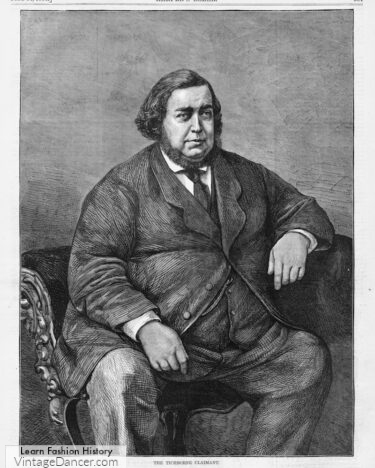
1873 the Victorian corpulent man was a common and celebrate character
There was little demand for ready-made extra large size men’s clothing, yet Sears and similar large retailers offered a few basic choices. 1 dress shirt, 1 casual shirt, 1 cardigan, and 1 underwear. Suits with vest and trousers were still made-to-measure.
- 1898 soft shirt- percale and madras
- 1897 men’s overshirt- cotton sateen or percale
- 1899 cardigan sweater in black or brown
- 1897 men’s suit
- 1899 made to measure cutaway suit
- 1897 single breasted suit
1900 -1910s Photos
Fine three peice suits and more casual 2 piece summer suits and separates.
- G.W Young, 1910s
- 1907 William Taft
- 1910s Tim Woodruff, seersucker suit
- 1916 actors LV Hamilton and B. Ducan
- Working class photographers assistant
- 1917 Fatty Arbuckle
1920s Men’s Big & Tall Clothing
The standard choice in suiting for men in the 1920s was still the single breasted suit in small stripes or subtle pattern, unless you were Fats Domino. Large men dressed in casual clothing too, just like any thinner man of the era. Summer whites for sport or leisure, belted trousers and casual shirts for any time.
- 1922 H.W. Thornton
- Mahmoud Samy Pachaand
- Walking the Boardwalk, in summer style
- Irish-American tenor John McCormack in summer whites (tennis?)
- William Howard Taft
- Casual clothing
1930s Men’s Portly Clothing
The term portly was used briefly in the 1930s. The ideal 1930s man was muscular and lean, a far cry from portly figures yet an aging population made the expansion of men’s extra large clothing a necessity. Suits were trim and neat up top with wide leg trousers that hung straight down the leg. Medium to dark grey was the best seller.
- 1932 grey suit
- 1934 grey suit
- 1939 Chief Justice and Mrs. Hughes
- 1934 flat front striped trousers
- Trousers with suspenders
- Trousers with self adjusting D ring belt
Sears continued to sell men’s underwear (union suits) in average, tall-slim, and stout sizes. They added the new boxer style underwear in these sizes too. Underwear was a big seller for mail order catalog companies which is the reason why they added the wider size range for them.
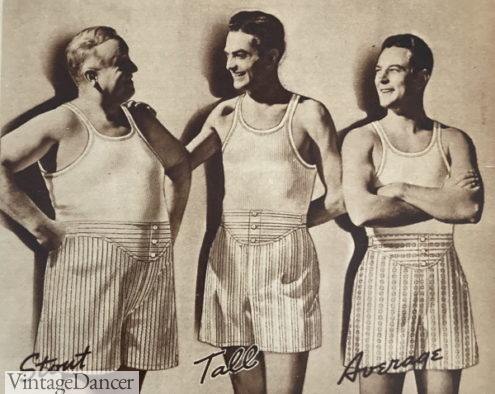
1938 mens boxer style underwear in stout, tall and average sizes
1940s Vintage Big & Tall Clothing
With most young men off at war getting in the best shape of their lives and older men wearing out their 30s clothing, there was little new to the market in the 1940s.
The only noteworthy change was that big men were finally encouraged to wear double breasted suits and in brighter colors (midnight blue, medium brown, light grey.) Bigger (broad and sturdy) was the fashion style of the day.
- 1940 big men’s suits
- 1940s DB suit were now acceptable for large men
- 1941 well coordinated
- Fats Waller
- 1941 trousers with belt
- 1945 “husky” teen boy casually dresses
1950s Big Men’s Clothing
The 1950s renewed interest in men’s classic tailoring but with updated pairings. Big men continued to wear high rise pants over the belly or at the high waist if the middle wasn’t too big.
Clothing was offered in larger sizes throughout catalogs and department stores as part of a normal range of men’s clothing. The options were still far fewer then regular sizes but at least there was some off the rack options.
Several actors, mostly older men, made a name for themselves on the silver screen. They played the comic, wise grandfather, and detective roles. They usually wore their own clothing instead of relying on the costume shop to provide them. Thomas Gomez, Jackie Gleason, and Francis L. Sullivan are a few noteworthy names.
- Snazzy pinstripe DB suit
- Fats Domino, musician, always had good style
- John McGiver, stage actor
- Thomas Gomez
- 1950s casual T shirt, pants and belt
- Jackie Gleason, golf attire
And that concludes this brief look at men’s vintage big and tall size clothing.
Where can I buy men’s vintage big and tall clothing?
That’s a million dollar question. Genuine vintage clothing in larger sizes is a lifelong hunt for many men. The few pieces that pop up for sale are quickly snatched.
Your best bet tis to start networking. Let local vintage shops know your size. Befriend other men online and pick up re-sells or trades from them.
Go to estate sales (better yet, volunteer and get in on the early access.) Look for live auction houses in your area (this is where I found a goldmine of clothing in my husbands size. But it only happened once.) Be open to later decades such as 70s does 30s, or 80s does 20s, for the look that is slightly easier to obtain.
Vintage reproduction clothing for larger sizes is not easily found, off the rack. Custom made pants and dress shirts will be your best options for formalwear.
Casual clothing can be found in your regular shops, especially as retro and vintage fashion trends go through a revival. A few to look at are:
Paul Fredrick– Excellent shirts, good suits. Wide size range. More classics than vintage but I find a lot here.
Blair – I like their 50s-60s camp shirts and polo shirts. They tend to fit wide and boxy instead of skinny fit like most other shops.
Luxire – Customer made to measure pants, shirts, and more. Tailoring like it used to be at a good price point.
Marks and Spencer – Clothing up to 4xl. Not vintage but when vintage in trendy they will have good classic pieces.
Men’s Warehouse – Good for basic and staple pieces. Occasionally trendy vintage inspired looks.
Steady Clothing – Camp collar 50s-60s rockabilly shirts up to 4XL. Really nice, durable shirts.
Natty Shirts – Made to order dress shirts. The Spearpoint collar shirt is a classic late ’20s and ’30s style for a very reasonable price.
Short and Fat – Men’s basic button down shirts for the short and fat man. Not vintage but good for basics.
Stanley Briggs Casual vintage British wool knitwear in longer lengths.
Old Field Clothing – A mix of 1920s – 1940s men’s classic clothing and workwear. Some in larger sizes/longer lengths.
Groovin High Brand– Has vintage knit pullovers (40s-50s) with a longer hem.
Chester Cordite– Suits and shirts up to a 46. The owner is tall and lean so sizing tends to benefit the tall men.
Old-Town – Custom made suits, trousers and jackets. Any size.
Reeses Vintage Pieces – Probably the best collection of real vintage clothing, especially suits, many in sizes above 48. Contact him with your measurements.
More men’s vintage reproduction brands to browse.
Have a suggestion for this list? Need help with your outfit? Please send me a message.
Debbie Sessions has been teaching fashion history and helping people dress for vintage themed events since 2009. She has turned a hobby into VintageDancer.com with hundreds of well researched articles and hand picked links to vintage inspired clothing online. She aims to make dressing accurately (or not) an affordable option for all. Oh, and she dances too.
